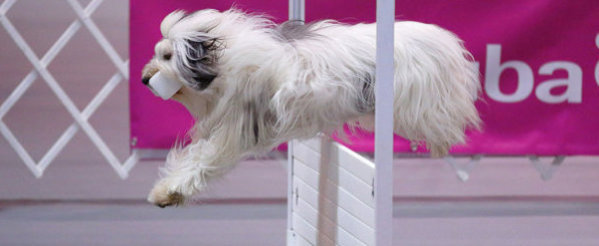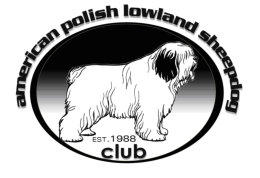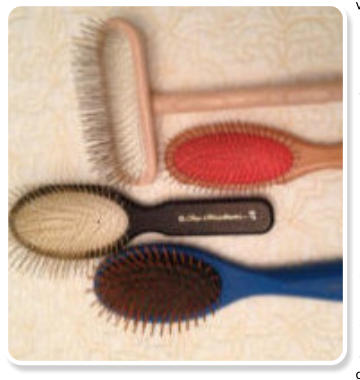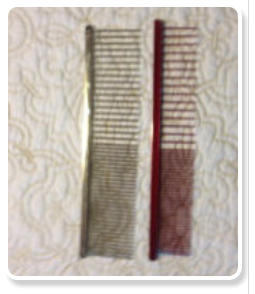






Home of Polish Lowland Sheepdogs
GROOMING YOUR POLISH LOWLAND SHEEPDOG
Every PON puppy should be brushed on a regular basis to get him or her used to the experience. It is a good idea to start
when they are young, getting them used to bathing, brushing and drying. You might want to consider brushing for a few
minutes every day, getting your PON accustomed to lying still. He should learn this is a pleasant experience. Another
good habit is to get your puppy used to having his feet and toes held. Eventually, somebody will be trimming or grinding
his toenails. You can start by holding each toe for a few seconds, and repeating this every day or so. If your PON goes to
the grooming salon, the groomer will appreciate your efforts in familiarizing your PON with the grooming process. If you
are the one who maintains your PON, you will be glad you spent the time patiently teaching your puppy about the
grooming experience.
If you are going to keep your PON in a puppy or “Summer” clip, you still need to do routine brushing to keep the coat free
of debris such as grass, weeds, flower blooms, all things that tend to stick to your PON’s coat, and keeping the coat free of
mats. If you are not taking your PON to a groomer on a regular basis, you also need to keep the ears clean and free of
debris, and keep the toenails trimmed. Some PONs require more frequent bathing than others, and there are differing
viewpoints on the required frequency of bathing.
If you want to keep your PON in a full or show coat, you need to
be prepared to thoroughly brush at least once a week. Some
PONs need to be brushed more frequently, and others can be
brushed every 2 weeks. Just be certain to keep the coat mat
free, regardless of how frequently you need to brush. NEVER
BATHE A MATTED COAT. If you are going to maintain a show
coat, a good dryer will be indispensible. There are many good
dryers available, though many are quite pricey. You can start
drying your puppy’s coat with a regular hair dryer on a cooler
setting, getting the PON used to the experience of being dried.
Once the coat becomes more profuse and your PON becomes
larger, a dog dryer will probably be considered a necessity.
To keep the PON coat in its best condition, you need a good pin
brush (or 2 or 3). The bristles should not be too stiff or harsh.
Brushes without ‘balls’ on the tips tend to be gentler on the coat.
You also need combs, preferably the ones with both a fine tooth
and a coarser tooth. Another good brush is a wooden bristle
brush (such as the one by Chris Christensen). The important
thing is to remove as little hair as possible while still keeping the
coat mat and tangle free, making sure that you are grooming the
full length of the hair from the skin to the tips of the hair. It is a
good idea to keep a sprayer with diluted conditioner or a special
conditioning product to spritz on the hair as you brush and comb to help minimize breaking the coat. (see links below)
One method of being sure you brush the entire coat is to brush the leg starting at the foot and working up. Make sure
there are no little mats forming between the toes. Then brush from the topline of the dog down to the belly. Pay careful
attention to the areas of the ‘armpits’ which are prone to matting because of friction in that area. Brush the entire chest by
starting in the area between the front legs and working up to the chin. Brush the face using caution around the area of the
eyes, and being sure to brush the entire area beneath the ears, another area where mats are frequently a problem. Make
sure you have brushed the entire neck area and the top of the head.
Eventually, despite your most dedicated efforts, you will encounter the dreaded mat. Mats take time and patience, but
unless the dog has been allowed to become completely matted, you can usually remove the mats by carefully spreading
the mat apart with your fingertips, working it into smaller sections and then carefully combing. Patience is needed with
mats as removing mats will take time. If the coat is badly matted, it may take several days to completely remove all mats.
There are many good products available to help with removing mats, and you can use baby powder with cornstarch, or
plain cornstarch which will help when you try to comb through the mat itself. If using one of the commercially available
products, read the instructions carefully. If using cornstarch or baby powder, carefully massage the powder into the mat by
working the hair between your thumb and fingertips. Working with a comb, begin to clear the mat by combing first from
the end of the hair and working your way back to the skin. Never ‘rip” chunks of hair from your PON. If this method fails,
and you still have a mat, you can carefully scissor lengthwise through the mat. Never cut the hair crosswise, shortening
the hair. Remember, if you do not get the mat removed completely, it will inevitably just get worse. Scissoring behind the
legs or under the ears is less noticeable and might be considered helpful because these are sensitive areas. Remember,
if you are showing your PON, he needs to be in his natural coat without scissoring, so you need to use scissors in only the
most extreme situations.
Once your PON has been completely brushed, you are ready to bathe. You may want to place cotton balls in the ears to
keep water or shampoo from getting into the ear canal. Use a good quality shampoo, being sure to completely rinse
without leaving any residue. Using a conditioner is a personal preference, based on
the coat of your PON. If you use a conditioner, be sure it is also completely rinsed.
Shampoo or conditioners left in the coat tend to result in matting more easily and
may result in skin irritation. There are conditioners which can be sprayed on after
the bath that are not designed to be rinsed. Be sure to read the label instructions
thoroughly.
Once you have thoroughly rinsed the coat, you should blot the coat thoroughly,
squeezing the coat firmly to remove as much excess water as possible. Do not rub
the coat as this may cause tangles. After blotting the coat as much as possible, you
may leave the PON to air dry for awhile or you can move him to a grooming table for
drying. Drying will take less time if you have allowed the coat to dry somewhat
before you begin the drying process. When ready to dry your PON, place him/her
on the grooming table and once again, start drying one section at a time, making
sure the coat is dry and free of mats. Again, pay careful attention to the area around
and beneath the ears and the areas where the legs join the body as these are areas
that are most prone to matting and are sometimes more difficult to dry thoroughly.
This will give you a great opportunity to check the skin for any signs of irritation, as
the dryer separates the hair exposing the skin. Be careful not to get the dryer too
hot or too close to the skin while drying.
After your PON is thoroughly dried, you should carefully trim the excess hair between the pads of the feet. You can trim
the hair by using small blunt-end scissors or you can use electric clippers, being careful not to trim hair above the toes.
You should also shorten the toenails either by using a good nail clipper or using a grinding tool such as a Dremel (see links
below).
At some time in the grooming process, you should carefully clean the ears, being sure the inside of the ear does not retain
any moisture. Your veterinarian may recommend using a special solution to dry any retained moisture within the ear itself.
You should also remove any excess hair from within the ear itself.
For maintaining the coat during times when you are not showing, you might want to consider putting your dog in a heavier
conditioner or using a spray-in oil mixture next to the skin. Most mats will occur close to the skin. The oil will help prevent
matting and will also help protect a coat, especially if it tends to be dry or brittle. You can prepare an oil mixture by mixing
one part conditioning rinse, eight parts water and a drop or two of lanolin. If you are going to spray an oil mixture onto the
skin, you should dry the coat completely while brushing without brushing the oil to the tips of the coat where it will likely
cause the coat to collect more dirt. If you choose to put this oil mixture on the skin and coat, you will need to bathe
thoroughly before going to a show.
Ask other PON owners for hints on grooming and grooming equipment. Most will gladly share tips they have learned
along the way.
A Few Helpful Beginner Grooming Supplies:
20mm Ice Slip Dematting Brush 20mm Oblong Pin Dog Brush Karben Slicker Brush for Dogs 9in Coarse Poodle Butter Comb Greyhound Style Fine/Course Butter Comb Dremmel Pet & Dog Nail Grinder Diamond Dremel Dog Nail Grinder Attachment Dog Nail Clippers All Systems Super Cleaning and Conditioning Pet Shampoo Cowboy Magic Detangler Pet Grooming Spray Ready-to-Use- prevents matting A Few Advanced Grooming Supplies: 36” Dog Grooming Table Force Dryer Dog Grooming Blower Pro Hair Scissors 6.5″ Professional Animal Dog Clippers
American Polish Lowland Sheepdog Club















